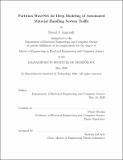Partition WaveNet for deep modeling of automated material handling system traffic
Author(s)
Amirault, David J.(David James)
Download1192538566-MIT.pdf (2.886Mb)
Other Contributors
Massachusetts Institute of Technology. Department of Electrical Engineering and Computer Science.
Advisor
Duane Boning.
Terms of use
Metadata
Show full item recordAbstract
The throughput of a modern semiconductor fabrication plant depends greatly on the performance of its automated material handling system. Spatiotemporal modeling of the dynamics of a material handling system can lead to a multi-purpose model capable of generalizing to many tasks, including dynamic route optimization, traffic prediction, and anomaly detection. Graph-based deep learning methods have enjoyed considerable success in other traffic modeling domains, but semiconductor fabrication plants are out of reach because of their prohibitively large transport graphs. In this thesis, we consider a novel neural network architecture, Partition WaveNet, for spatiotemporal modeling on large graphs. Partition WaveNet uses a learned graph partition as an encoder to reduce the input size combined with a WaveNet-based stacked dilated 1D convolution component. The adjacency structure from the original graph is propagated to the induced partition graph. For our problem, we determine that supervised learning is preferable to reinforcement learning because of its flexibility and robustness to reward hacking. Within supervised learning, Partition WaveNet is superior because it is both end-to-end and incorporates the known spatial information encoded in the adjacency matrix. We find that Partition WaveNet outperforms other spatiotemporal networks using network embeddings or graph partitions for dimensionality reduction.
Description
Thesis: M. Eng., Massachusetts Institute of Technology, Department of Electrical Engineering and Computer Science, May, 2020 Cataloged from the official PDF of thesis. Includes bibliographical references (pages 75-79).
Date issued
2020Department
Massachusetts Institute of Technology. Department of Electrical Engineering and Computer SciencePublisher
Massachusetts Institute of Technology
Keywords
Electrical Engineering and Computer Science.